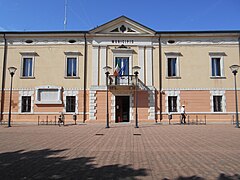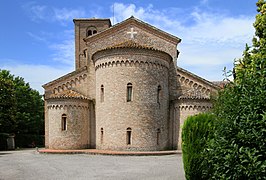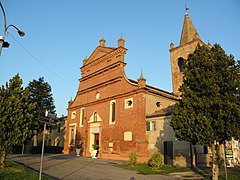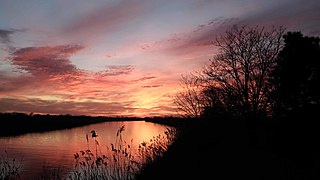Ostellato
| Ostellato | ||
|---|---|---|

|
|
|
| Country | Italy | |
| region | Emilia-Romagna | |
| province | Ferrara (FE) | |
| Coordinates | 44 ° 45 ′ N , 11 ° 56 ′ E | |
| height | 2 m slm | |
| surface | 173 km² | |
| Residents | 5,849 (Dec. 31, 2019) | |
| Population density | 34 inhabitants / km² | |
| Post Code | 44020 | |
| prefix | 0533 | |
| ISTAT number | 038017 | |
| Popular name | ostellatesi, ostolensi | |
| Patron saint | San Pietro e Paolo | |
| Website | www.comune.ostellato.fe.it | |
Ostellato is an Italian commune ( comune ) with 5849 inhabitants (as of December 31, 2019) in the province of Ferrara in the Emilia-Romagna region .
Geographical location
Ostallato is located 22 km west of Comacchio on the Canale Navigabile , a shipping canal approved for ships up to a size of 1,350 GRT, which is an extension of the Magnavacca Canal ( Canale Magnavacca ), which flows into the Adriatic Sea at Porto Garibaldi , and the Canale Magnavacca to the west of Ostellato Migliarino flows into the Po of Volano ( Po di Volano ). The SP 1 road runs parallel to the canal and connects the town with Comacchio and the port of Porto Garibaldi. The provincial capital Ferrara is 31 km away. Ostellato is on the Ferrara - Ostellato - Codigoro railway line , the terminus of which is Codigoro.
history
Historians suspect a connection between the place name and Latin terms such as hostullatum (resting place), hostium (gate, mouth, river) or ostulatus (burnt village). What is certain is that the area of Ostellato was already densely populated in Roman times. In 1731 a Roman necropolis was discovered by chance near Fossa Nogarole in the village of San Giovanni . In 1955 an archaeological excavation campaign was carried out. The necropolises of Vallone, Quinta, Punta Schè and the necropolises found at the (recently closed) sugar factory 'Coprob' have now also been settled in Roman times.
In the early Middle Ages (9th century), Ravenna exerted a great influence on the region, which reached its peak after Christianity prevailed. The Church of Ravenna did not shrink from extending its claim to rule to include estates and estates that had been assigned to other local jurisdictions at the center of conflicts of interest of representatives of competing political groups. As stated in the Cronica Parva , up to five different dioceses were represented within a radius of five to six miles in the 13th century.
When the Estensi expanded their duchy - the title of duke was originally from the Roman-German Emperor Friedrich III. was purchased - the administrative subdivision of the region was largely reversed, but a certain dependence of some churches of Ostellato on the Diocese of Ravenna has remained to this day.
As can be seen from old documents, Medelana d'Este had a pleasure palace built in Ostellato, today's Villa Dal Buono , which was probably built on the site of a previous ancient settlement. The pleasure palace was temporarily the residence of Lucrezia Borgia . In Ostellato she met the poet and philosopher Pietro Bembo , who gave her a copy of his book Gli Asolo ('The Inhabitants of Asolo'). Bembo probably met Lucrezia Borgia in the residence of Ostellato, probably identifiable with today's Villa Tassoni . Later, Marfisa d'Este often used the built summer palace. She left it to Torquato Tasso for a while so that he could recover from a hospital stay there. The Renaissance villa of Tito Strozzi , which was destroyed , probably stood in the immediate vicinity of today's town hall .
After the Duchy of Este in 1598 for lack of heirs to the Papal States had fallen, existing in the region technical facilities were neglected for groundwater regulation and drainage of the marshes. The consequence was a progressive swamping of agricultural areas and the associated poor hygienic conditions. In order to prevent the spread of epidemics, it was decided to subject the swampy lowlands to a 'cleansing cure'. A dam was pierced and sea water was discharged. More dam punctures soon followed until almost all of the lowlands were flooded in the 17th century. This led to a dispute with the municipality of Comacchio over fishing rights in the lagoons.
At the beginning of the 18th century, on the verge of the War of the Spanish Succession between the Roman-German Emperor Joseph I of Austria and Pope Clemens XI. a dispute broke out over the ownership of the Comacchio county. Imperial troops, led by Count de Bonneval , moved into Comacchio and the region around Ferrara in 1708 . When de Bonneval was ambushed and wounded in the arm in Ostellato, he had the place looted and pillaged. Over two hundred civilians are said to have died.
In 1744 an agreement on lagoon fishing was negotiated with Comacchio, meaning that Comacchio was granted exclusive fishing rights and the municipality of Comacchio in return had to pay annual compensation to the municipality of Ostellato.
After the invasion and occupation of Italy by French troops, the lagoons, which at that time had been the allodial goods of Ferrara, Bologna and Ravenna, were ceded in 1797 to the government of the vassal state of the Cisalpine Republic created by Napoleon Bonaparte , which in turn sold the lagoons to the municipality of Comacchio. After the defeat of Napoleon and the restoration of the papal government, this sales contract was declared valid. Despite this, the lagoons, including the Comacchio saltworks, were again directly administered by the Papal States. Because of the bad political climate and the unrest of robbers, many fishing tenants withdrew from the Comacchio lagoons.
Population development

Attractions
- Pieve San Vito, a church building from the Middle Ages (11th century) in the San Vito fraction , approx. 5 km west of Ostellato. The building, which was built on the remains of a church from the 6th century in the Romanesque style and expanded in 1207, was rebuilt in 1686 and its style changed significantly. A few years ago the building was restored in the original Romanesque style.
- Municipal Museum of the Natural History of the Po Delta ( Museo Civico di Storia Naturale del Delta del Po )
- Numerous structures from the 16th and 17th centuries have been preserved in the vicinity of Ostellato.
- The three lagoons of Ostellato (120 hectares in total), which line up on the Canale Navigabile and the Canale Circondariale and which are a remnant of the measures to drain the Mezzano lagoon ( Valle Mezzano ). One of these lagoons, a biotope of native flora and fauna, is followed by a park with a restaurant and leisure facilities. 25 sculptures on the subject of 'Heaven, Earth and Stars' are set up along the natural paths and were created by 25 different Italian artists.
Web links
Individual evidence
- ↑ Statistiche demografiche ISTAT. Monthly population statistics of the Istituto Nazionale di Statistica , as of December 31 of 2019.
- ↑ cf. also: Annual report on the progress of all medicine in all countries in 1846 , 1st volume Biology, Erlangen 1847, p. 190 .
- ↑ Carl Gustav Carus : Analects for Natural Science and Medicine - collected on a trip through Italy, in 1826 , Dresden 1828, p. 99 .
- ^ Andreas Lazarus von Imhof: Newly opened historical picture room , 7th part, Nuremberg 1719, pp. 302–309 .






